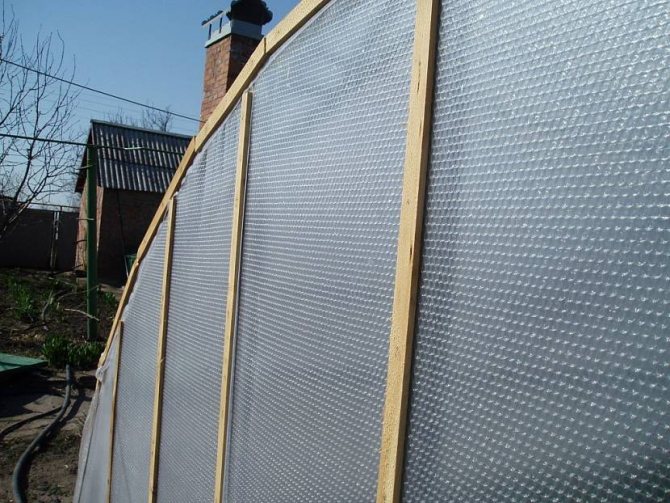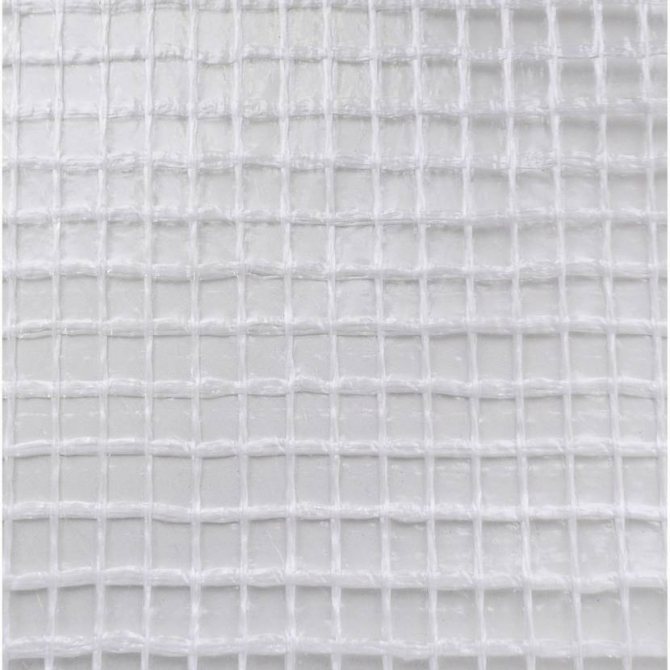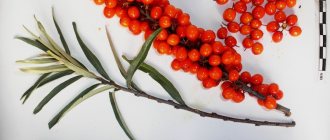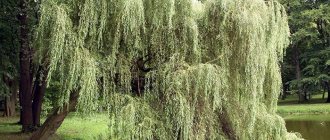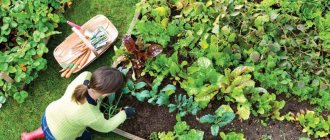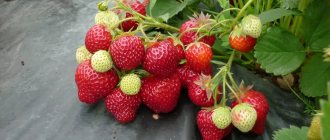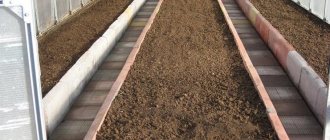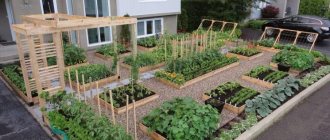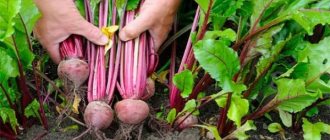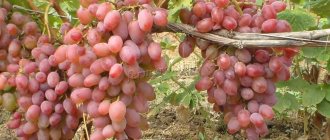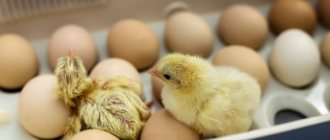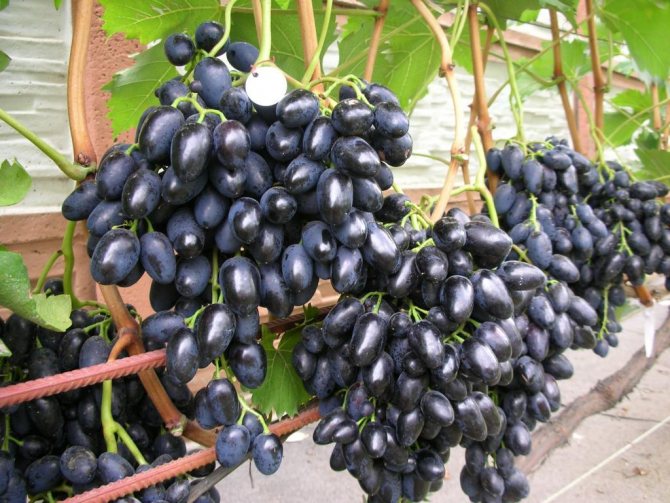
Every year, with the arrival of spring, farmers start a hot sales period. There is a threat of recurrent frosts that cannot be foreseen. In such situations, young plants require mandatory shelter. Previously, plastic wrap was used for these purposes, but the modern market diversity can drive any gardener into a stupor. Surely many have heard of Russian-made agrotex or spunbond, as well as French agrile or German lutrasil. These materials belong to the new generation of covering materials, which are designed to preserve plants growing in open ground.
To protect the beds from weeds, as well as for mulching, the above materials are used in black. In order to choose the right covering material for yourself, it is necessary to study the characteristics of the lutrasil and spunbond materials, as well as other types and their differences. This is the only way to make the right choice at the time of purchase.
Agrotechnics
For those who do not trust nonwovens, there are also agrotechnicals on sale. They also exist in different densities and colors (white, black, gray and green), that is, they can be used for different purposes and in different areas.
Greenhouses and the first plantings are usually covered with white agro-fabrics, and the soil is mulched with black and colored ones, protecting it from weeds and contributing to accelerated warming.
For perfectionists and lovers of neat beds, black agrotechnical fabrics with painted cells appeared on sale. Now you do not have to mark the surface of the ridge along a ruler - it is enough to plant a bush in the middle of the already marked square and you can admire the even rows of plantings.
Do not forget that the temperature under the covering material is always higher than in the open air, and this problem is especially relevant for greenhouses. Before planting plants in a shelter, think about how you will regulate the temperature and humidity in the shelter.
A little about the manufacture of spunbond
In the 21st century, scientists have given rise to a new technology in the field of polymers. The synthetic substance melt passes through special filters in the form of threads. They form the web on the conveyor. After the material is processed so that it becomes marketable and wrapped in rolls.
The spinning method of manufacturing allows you to obtain a dense nonwoven fabric with amazing properties:
- low crease;
- frost resistance;
- durability;
- heat resistance;
- durability.
In addition to the use of canvas for the manufacture of disposable clothing in medicine, farmers saw great opportunities for use in spunbond.
Enterprises produce canvas with various characteristics. For use in agriculture, a density of 17 to 60-80 g / m2 is suitable. Such a covering material is good for use in open and protected ground.


About covering material for beds in bookmarks 62
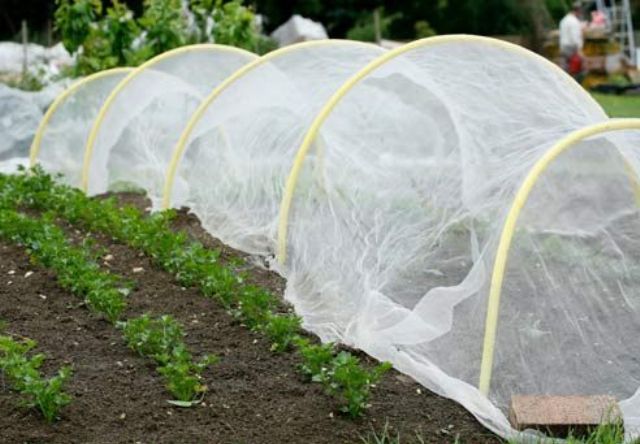

There are various covering materials in different densities and colors. Each is suitable for its own purposes.
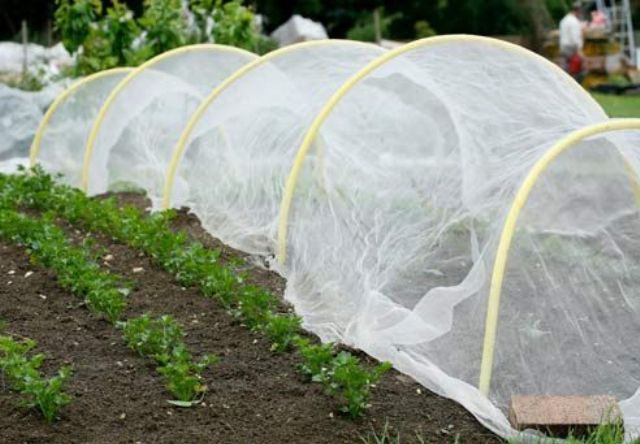

nonwoven polypropylene fiber
For the device of a frameless greenhouse, a light white material with a density of up to 17 g / m² is suitable. This non-woven material is used to cover the garden bed to accelerate the emergence of seedlings and to protect them from temperatures down to zero degrees.
In addition, seedlings covered with a covering material are protected from some pests. You can cover the beds of radish, cabbage, radish, onion, carrot with such a non-woven material.
You can leave such material in the garden for a long time and even water through it. Loose non-woven fabric is suitable for protecting the testes of carrots, dill, parsley (you can sew small bags and put them on).
Temporary tunnel shelters and greenhouses on arches are covered with white covering material of medium density (28-35 g / m²).
A denser white covering material (35-45 g / m²) is suitable for spring greenhouses. Stationary greenhouses, the service life of which is designed for the whole summer, is best covered with non-woven material of a higher density - up to 60 g / m². Such a covering material will protect plants from frost, scorching sun, wind, hail. In addition, such material can be used to shelter podwinter crops and heat-loving plants from freezing in winter.
In specialized stores, you can buy arcs of different lengths and diameters, which are easily installed on the garden. Special fasteners fix the covering material on arcs, and from below it can be pressed to the ground with large stones or boards.
it's hard to say which type of protective covering products is better. Summer residents quite successfully use both proven traditional burlap or plastic wrap, as well as new materials.
These include spunbond polypropylene fiber materials, which are environmentally friendly lightweight nonwovens.


If the polyethylene film is absolutely air and moisture resistant, then spunbond creates a minimum barrier for the necessary light, water and air to penetrate through its pores.


Lutrasil on the site
Mulching
It is customary to mulch paths, aisles and the plantings themselves with black lutrasil.
In the spring, the bed prepared for planting crops is covered with black lutrasil and cuts are made into which the plants will be planted:
- strawberry
- tomato
- cucumbers
- other cultures
Watering them is carried out in the same holes. Condensation does not collect on lutrasil, excessive dampness does not form under it, mold does not appear and the earth remains loose. Nowadays, there is a two-color non-woven material for mulching beds. The top side is white to prevent excessive heating of the root system. When creating decorative paths, strips of lutrasil are laid under the main coating. This prevents weeds from growing on the paths. The average service life of a mulch coating is three years.
Protective cover with lutrasil of plantings
Lutrasil with a density of 17 g / sq. Lutrasil with a density of 40 - 60 g / m2 is used for the construction of greenhouses and greenhouses. It is important that under the non-woven coating there is an unhindered penetration of air. If pollination is necessary, it is very easy to remove it for a while. The denser the lutrasil, the longer it serves on the site. Plants grown under such shelter develop better and yield earlier crops. To see this, it may be worth making small experimental beds and greenhouses out of lutrasil.
With the arrival of spring, every summer resident has a time of trouble and worries about his new "wards" and their comfortable stay during the periods of the first spring frosts. We try to cover young plants as best as possible, creating an optimal microclimate for them. We all know well such a covering material as plastic wrap, but the choice is not limited to this. I propose to take a closer look at the features of each material in order to understand what and for what we can be useful. It's about artificial origin.
Technology and application features
Spinning technology is a method for the production of small diameter man-made fibers. They are resistant to acids, alkalis, microorganisms and have a low specific gravity.
Here, man-made fibers are usually produced by extruding (forcing) a polypropylene melt through a plurality of thin capillaries in a die.
Being laid in a canvas in a softened state, the threads (fibers) stick together, and a finished non-woven fabric is obtained, often called spunbond, like the technology of its production itself.


If the polyethylene film is absolutely air and moisture resistant, then spunbond creates a minimum barrier for the necessary light, water and air to penetrate through its pores.
- Agrospan 17 or Agrospan 30
- AgroSUF 17 or AgroSUF 30
- Lumitex 17 or Lumitex 30
- Lutrasil 17 or Lutrasil 30
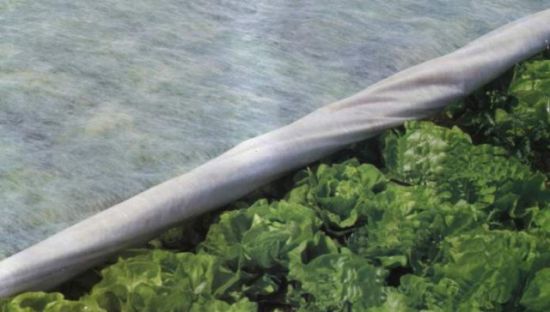

Plants under spunbond develop in a favorable microclimate, and they can be watered directly through it.
Apply spunbond in this way. Immediately, as soon as the seedlings are planted or the seeds are sown, a roll of covering cloth is unrolled in the garden bed and sprinkled with earth in several places along the edges.
To prevent the plants from being pressed down as they grow, the canvas is periodically lifted. The beds are watered and water-soluble mineral fertilizers are applied directly through the agro-protection.
A sudden spring frost on the soil can severely damage plants. Therefore, for their protection, it has long been customary to use covering material for beds.
This includes fabrics with a density of 13 to 30 g / m2.
- They cover the beds with both farmers on large areas, and gardeners or summer residents, since the canvases are low prices, and their service life can be several seasons.
- They are the thinnest of all available analogues and serve as good protection for young plants from heat or cold, including a short-term drop in temperature to −2 ° C.
- They serve as excellent protection of crops and seedlings from birds and insects.
- The structure of the nonwoven fabric is capable of transmitting light, air and moisture, while creating the required microconditions for the confident growth of plants.
- The agricultural cover will provide a bountiful harvest of vegetables, ripening two weeks earlier than usual.
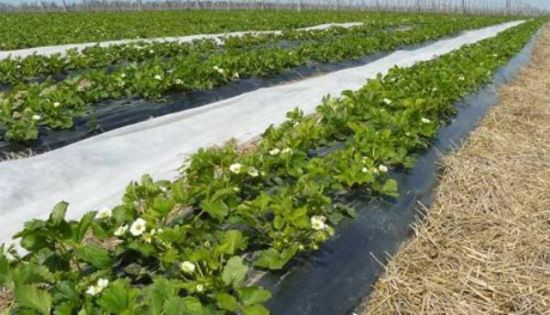

Black covering spunbond material prevents weeds from growing in the beds, and also protects lawns from being washed away by rain or drying out in summer
Density of non-woven polypropylene fiber
- 17-30 g /m²
- a material with such a density range would be just right for my purposes. It is able to protect plants in open ground from strong sun and short spring frosts at night, and due to good air, water, light permeability and good thermal conductivity, it helps to organize a special microclimate for plants for the best growth and development. The advantage of this material is also protection from birds and insects. Shrubs, berries, vegetables, fruits and ornamental plants, mainly growing in open soil, are covered with a material with a density of 17-30 g / m².
Lutrasil with a density of 17-30 g / m2
- 42-60 g /m²
perfect if you plan to build a greenhouse with arches and provide the plant with a winter shelter.
Shelter made of non-woven fabric with a density of 42-60 g / m²
- 60 g /m²
- a material of such density "for the lazy", its benefits more than pay off its market value. In the production of the material, some companies add a UV stabilizer, which extends the life of the canvas. And the addition of carbon black gives the nonwoven fabric a black color. This color promotes greater absorption of sunlight, plants receive more heat, but the weeds, being under such a shelter, "do not see" the sun and die. Black is most often used as mulch, white is stretched over frameworks for plant protection.The structure of the material is such that it is perfectly permeable to moisture. Therefore, watering and applying liquid fertilizers will not be difficult.
Covering roses with lutrasil with a density of 60 g / m²
There are so many different offers on the market now that it's hard not to lose your head. By and large, the essence of all brands of covering nonwovens is the same. The difference is in proprietary manufacturing technologies and, of course, in price and quality. The most popular on the Russian market, it seems to me, is still spunbond, the name of which has actually become a household name for covering materials, like diapers for diapers or copiers for copiers.
Shelter for arc greenhouses and greenhouses
- For covering arc greenhouses and frame greenhouses, non-woven fabric with a density of 35 to 60 g / m2 is used.
- They can also cover seedlings of shrubs and trees from freezing in winter.
- Such a blanket allows air and water to pass through, and also protects plants from a drop in temperature to −3-4 ° C and exposure to cold fogs.
- Under such protection, a microclimate favorable for the development of crops is created in a greenhouse (greenhouse), which leads to an increase in their growing season.
- The canvas is highly durable; is produced with the addition of a UV stabilizer, which extends its service life up to three seasons.


The covering cloth is applied throughout the entire stage of the growing season of fruit bearing
Grades of this material:
- AgroSUF 42 or AgroSUF 60
- Lumitex 42 or Lumitex 60
- Lutrasil 42 or Lutrasil 60
Application at any time of the year
This environmentally friendly agrofibre can be effectively used on the site all year round.
Spring
In spring, thanks to its optimal density, spunbond protects plants from adverse weather conditions and sudden night frosts. At the same time, this material makes it possible to plant seedlings or start sowing ahead of schedule.
Protects spunbond young plants from birds, rodents, insects and other pests. In addition, even in arid regions, this material can be used to grow plants that cannot absorb moisture in the open field.
With the onset of summer, spunbond will serve as an excellent mulching material. At the same time, it will retain moisture and save the root system from overheating. Moreover, this agrofibre will slow down the growth of weeds and protect crops from dangerous pests.
In addition to textile material, organic elements are also used in mulching: compost, sawdust, hay and straw, peat, green manure, cut grass, bark, rotted foliage, needles.
The use of spunbond when growing gooseberries, blackberries, strawberries, strawberries, currants will help protect these crops from various diseases (gray rot) arising from the contact of fruits with moist soil.
Fall
In the autumn period, spunbond does not lose its relevance. It can be used for:
- protection from wind, hail, frost and other adverse weather conditions;
- preservation of plant germination;
- prolongation of daylight hours and, consequently, the period of fruiting.
In addition, this material will serve as a kind of analogue of the snow cover in late autumn, protecting crops from low temperatures.
Find out more about such covering material as Agrospan.
In winter, spunbond will also serve you faithfully:
- will provide plants with protection from freezing (strawberries, strawberries, winter garlic, etc.);
- will replace snow with little snow in winter, and in a snowy season it will not break even under a thick layer of precipitation;
- protects plants from the formation of an ice crust after a thaw;
- will prevent the roots from sticking out.
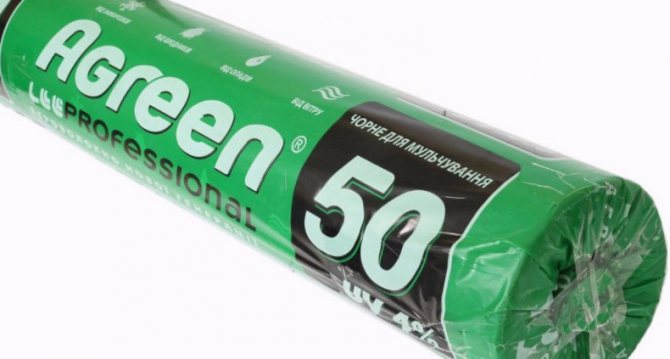

Black spunbond
- The black spunbond cover material prevents weeds from growing in the beds, and also protects lawns from being washed away by rain or drying out in summer.
- Its use suppresses weeds, evenly distributes moisture in the soil under the canvas, and contributes to the fact that the ground warms up faster.
- Artificial mulch is used by gardeners to prevent berries and fruits from contacting the ground.
- Agroprotection of this type can ensure a successful overwintering of plants during a winter with little snow. Mulch is also used to cover tree trunks for the winter.
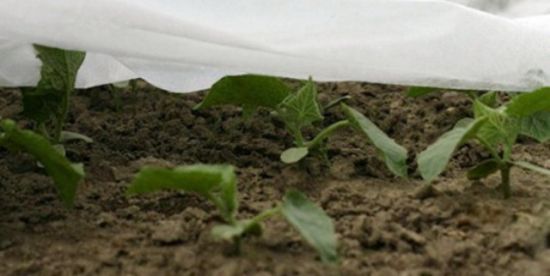

All numerous trademarks of covering nonwoven spunbod materials have approximately the same properties, but different purposes, determined by their density.
The material has the highest density of all existing non-woven agricultural cloths - 40-60 g / m2.
It is usually sold under the brands:
- Agrospan 60
- Agryl 60
- Lumitex 60
- Lutrasil 60
Covering cloth is used throughout the entire stage of the growing season of fruit bearing. Rolls of bedspreads are rolled out before planting on pre-prepared soil and sprinkled with earth in several places along the edges.
In places where plants are planted, cruciform cuts or round cuts are made.


When choosing such protection for a specific purpose (sheltering beds, greenhouses or mulching), pay attention to the two-digit number in the designation of its brand, which represents its "conditional" density
Manufacturers and retail price
The leading brands of nonwovens for agriculture are Lutrasil (Freudenberg, Germany), Agril (Avintiv, France), Agrotex (GK Hexa, Russia), Agrin (Unispan, Ukraine) and Plant-Protex (Poland). On the Russian market, you can buy spunbond of any manufacturer from official representatives and regional managers or in gardening stores.
For farms, the covering material is sold in rolls of 100 m or more, the most popular width is 160 or 320 cm. When ordering products, the dimensions may vary. For the needs of summer residents, manufacturers produce a canvas with a length of 10 m.
On the Internet, you can find specialty stores offering spunbond at manufacturer's price, while additional discounts are attached to wholesale. However, even retail will be quite acceptable for a private country house. The formation of the price per meter is influenced by the density of the material and the type of spunbond.
For wholesalers, the average price of spunbond with a density of up to 42 g / m2 is 3-6 rubles / m2, a density of 60-80 g / m2 will cost 7-12 rubles / m2. The average retail price (for 2020) for a pack of 10 m of canvas will be from 170 (width 320 cm, density 17 g / m2) to 550 rubles. (width 320 cm, density 60 g / m2).
Using agromulch
- reduces the amount of watering and evaporation of soil moisture;
- ensures rapid heating of the soil and constant maintenance of the required temperature;
- prevents soil contamination of fruits and berries, prevents rotting and mold of soil and plants;
- limits the growth of weeds, including perennial;
- reduces the amount of herbicide and pesticide application.
The soil, covered with mulch, does not undergo compaction, remains loose as long as the growing season continues without any additional cultivation. Left on the soil in winter, mulch serves as a reliable protection for plant roots from freezing. Its black color helps to absorb thermal radiation. This is very important for growing thermophilic melons and gourds.
All numerous trademarks of covering nonwoven spunbod materials have approximately the same properties, but different purposes, determined by their density.
Therefore, when choosing such protection for a specific purpose (sheltering beds, greenhouses or mulching), pay attention to the two-digit number in the designation of its brand, which represents its "conditional" density.
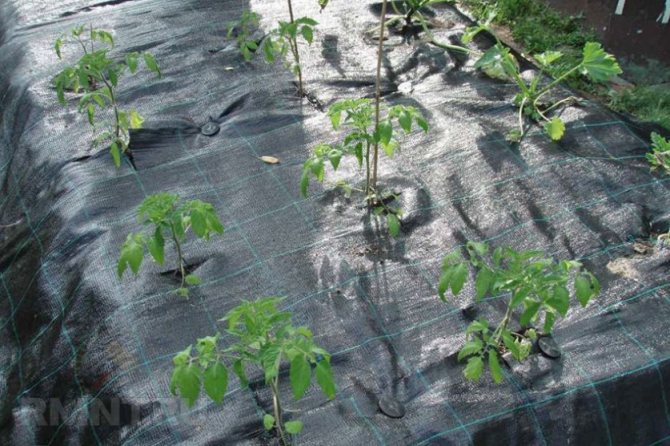

High density black non-woven fabric (60 g / m²) is used for mulching beds and trunks.
Under such mulch, the soil warms up faster in spring, and unlike the black film, moisture and air easily penetrates to the roots through the material.
Table: Purpose of the film
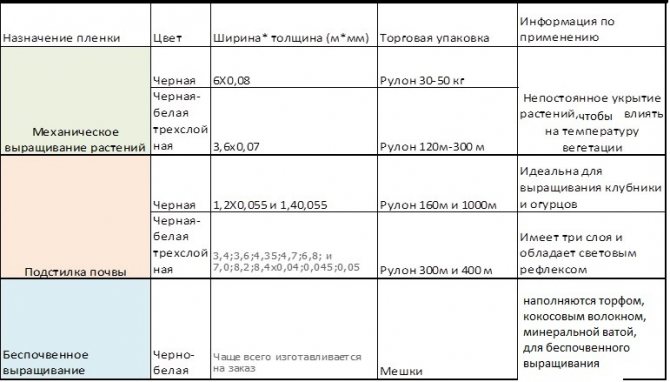

Shading meshes
Such nets are made of high-strength polyethylene tape. Used to protect plants from the bright sun in summer. Due to their strength, they can protect plants from hail and birds.


Many gardeners use shading nets to protect ripe fruits from falling damage, fixing the material under trees during the ripening of the crop, and some make special devices from them for drying vegetables, fruits, berries and mushrooms in the open sun.
Table. Comparative characteristics of covering materials
| Name | Main characteristics | |
| Light stabilized polyethylene film | It transmits and distributes sunlight well. Protection of plants from frost up to minus 6-8 degrees. Service life 1-2 years. | 18-20 |
| Reinforced polyethylene film | High strength of the material, service life up to 5 years. Possibility of repairing damaged areas. Good light transmission. Frost protection up to minus 8 degrees. | |
| Bubbled polyethylene film | Frost protection up to minus 10 degrees. Increased durability along with decent light transmission. Service life up to 5-6 years. | |
| Agrofibre white | Perfectly transmits light, air and moisture. Provides slight temperature fluctuations. Protects plants from frosts from minus 2 to minus 10 degrees - depending on the density. The service life also depends on the density - from 2 to 5-6 years. | |
| Agrofibre black | Destroys weeds. Promotes early warming of the soil. Improves soil structure. Perfectly permeable to water and air. Reduces the need for watering. Service life up to 6-8 years. | |
| Agrotkan | Destroys weeds. Promotes early warming of the soil. Improves the soil structure. Perfectly permeable to water and air. Reduces the need for watering. Service life up to 10 years. | |
| Polycarbonate | Excellent light transmission. Frost protection from 10 to 12 degrees. Ease of installation. Incredible durability - service life up to 20 years. | |
| Shading grid | Protects plants from the scorching sun, hail damage and birds. |
Decide for what purpose you need such material. When buying, pay attention to the description of the material and recommendations for use, where all the characteristics of the covering material must be indicated.
Nonwovens. Agrotextile
Everyone knows that any fabric material is created from threads that are intertwined with each other in a certain way and form a canvas. In modern chemical production, a technology has been mastered for producing threads from polymeric materials and connecting them with each other using:
- temperature regime, that is, by thermal methods
- using physical methods (needle-punched)
- using chemical methods of combined techniques
Nonwovens got their name from various methods. connections that exclude the way of weaving. Nonwovens are made from the following natural raw materials:
- cotton
- wool
From chemical fibers:
- polyamide
- viscose
- polyester
- polypropylene
- polyacrylonitrile
Nonwovens made of chemical fibers are widely used, including in the professional and amateur growing of fruits, berries, vegetables, flowers. They are collectively called agrotestyle. The main purpose of agrotextile is to protect and shelter plants, as well as to mulch the soil under the plants and between plantings. The most famous agrotextile is called spandbond. It is produced by hot blowing polymers. The purpose of the spandbond depends on:
- density
- weather resistance
- resistance to abrasion and crease
An important characteristic of spunbond for use in agriculture is its resistance to damage from sunlight.Special UV stabilizers are added to the polymer melt. It is worth saying that agrotextiles made from polypropylene using a technology called spandbond are called differently in different countries:
- Ukraine - agrofibre, AGREEN
- Germany - lutrasil, LUTRASIL
- France - agril, novagril, agril / novagril
Given the fact that earlier agrotextiles were most often imported from Germany, its more familiar name in amateur plant cultivation is lutrasil.
Covering material for beds - a description of how to choose
If you do not understand what a covering material is and what it is for, then here you can learn more about this device. If you understand that you need such a thing for the garden, then how to choose and how they differ from each other, we will also gladly tell you. The fact is that many different technologies have already been invented. To grow good vegetables with ease in all conditions. You can easily get good seedlings if you use a covering material. And as every seedling knows, the first stage that needs to be taken care of in order to end up with a strong and healthy harvest. If you fail this stage, then further work will be meaningless. And now many devices have already been invented to help you, and even without a lot of knowledge and practice in gardening, you can cope with this task the first time.
Covering material for beds
Of course, this does not diminish the role of the vegetable grower, but, nevertheless, such technologies exist not for simplicity, but to improve the growing process in general. Covering material is a versatile device, it is used for completely different growing methods. And the best part is that it is easy to find, since a wide variety of the required material is now on sale. But this also affects the appearance of complexity in the form of a choice, before you go to buy a covering material, you should understand how they differ and which one you specifically need. Because it happens that even sellers will not be able to explain or understand you in detail. The choice of the wrong material can become critical, the quality that will affect your seedlings. So here it is worth trusting only yourself, and independently calculate what exactly you want.
Covering material for beds
Spunbond, lutrasil, agril, spantex, agrosuf, agrospan - what is it?
Surely many of you have come across these outlandish names. An experienced gardener immediately understands what is at stake, but for a beginner it is like the alphabet of a new, unexplored language. All these are well-known trademarks, under which the material, which is extremely necessary in horticulture, is made, consisting of non-woven polypropylene fiber.
Covering material for beds
When I went to buy a non-woven polypropylene material for covering strawberries, I did not see the difference between the rolls, the consultant then also could not tell me what the fundamental difference is. When I brought home my purchase, it turned out that the material of the purchased density can be used to cover greenhouses in winter, but it is not very suitable for berries in the spring. Let's talk about the density of the nonwoven material.
Composition and application of the material
The covering material has the main difference in the form of the composition that is included in this or that material. You can see a wide variety of garden products in stores. It is worth paying special attention to the composition, then you can answer many questions about what this covering material is. It is the composition that speaks of its purpose. The most common types are divided into film and nonwoven fabrics. What does this mean? The materials of these covering sheets are distinguished by their density, and all this indicates the task for which this product is intended.
Covering material is used mainly for covering plants or building greenhouses. But many build small frames or cover the ground.
Comparisons of agrofibre and film
It is rather difficult to answer the question of which of the materials will be better. Each has its own characteristics. Shelters can also be combined with each other. But don't get hung up on tape or spunbond. They have various properties that can be intelligently applied to the benefit of their cultures.
If you come to your summer cottage only for the weekend, then it is not recommended to use a film. Cultures can be cooked under it if they are not opened during the day. In such cases, it is necessary to use agrofibre. Of course, after planting, the plants under the film will develop faster.than under spunbondbut later they level out in growth.
Spunbond is able to pass moisture through itself, so you do not need to reveal your plantings when watering. This way you can save a lot of time. Leaves, when in contact with agrofibre, will not die and undermine. But spunbond is unsuitable for use as a roof, for example, for sheltering tomatoes or grapes. These crops need to be protected from rainfall to avoid the development of fungal pathogens. In such situations, it is recommended to use a film, since spunbond does not cope with this task.
Under the film, the beds will warm up much faster, so it is worth covering the entire greenhouse with film. In order to maintain a comfortable temperature inside the greenhouse, a spunbond stretched over arcs is used or you just need to cover the plants with it from above. If you throw a film on vegetative plants, they will "suffocate and burn."
To preserve culturesgrowing outdoors, from precipitation and plants in the greenhouse from overheating - the roof must be made of film, the sides must be sheathed with agrofibre. Thus, the greenhouse can be ventilated without constant human intervention.
Varieties of covering material
Non-fabric covering material is usually used to cover the beds. You can purchase it and use it on different occasions. Almost everyone has such a thing, since not everyone has a way to cover seedlings or a vegetable garden in poor conditions. This is where such a thing will help. And so, every gardener has such a covering material. It is also called agrofibre, on websites and in stores you can find it under this name. There are several manufacturers that are often found and are in demand: Spunbond, Agrotex, etc. The thing is that non-fabric material is obtained from polypropylene. This difference should be looked for only in the composition and signatures, only connoisseurs can distinguish the material from polypropylene, because the material feels like a regular fabric. But as you understand, it is completely different in properties, and, despite the similarity, it has chemical elements in its composition, but agrofibre is not toxic, so there is nothing to worry about.
Covering material for beds
This material, in spite of its “unnaturalness”, is popular for its good air and water permeability. Beneath it, your garden bed will be kept cozy, agrofibre keeps warm and at the same time supplies all the necessary components. It's also nice that the material is UV resistant. In sunny weather, your plants will receive the right amount of heat and sun, but not scalded at high temperatures. Protecting the plant from direct rays is an important task. However, the growing conditions should be taken into account here; for some vegetables, the material should be raised so that they receive more sunlight and do not dehydrate. Many people choose it for all these qualities and a pleasant price, you can use it for a long amount of time, since it does not deteriorate at all, it can endure different conditions and thus has a long service life.
Covering material for beds
Polyethylene material is good for greenhouses. You can see many greenhouses made with film, and this method is very popular, especially among summer residents. An important parameter here is the cost, you can buy a large amount of such a film, arrange a whole greenhouse and not feel the price at all. But it is also important that this method of arranging a greenhouse will give good light transmission and shelter for your garden. Wind and frost are also not a problem for polyethylene. But you need to carefully prepare for the construction of such a greenhouse, because polyethylene is still not the most durable material, and if you use a large amount, on the contrary, you will get a higher density. If the film does not allow air to pass through, you need to ensure that the plants are kept in the right conditions and are not stolen, here you will need to provide this to your plants yourself. So a polyethylene greenhouse needs to be ventilated often. After rain, you should always clean the film so that the sun does not burn the plants through the drops. You will be surprised what a destructive combination the drops and the sun's rays create.
Polyethylene films
Until now, plastic wrap has not lost its position. First of all, every gardener is attracted by its price. As a rule, the film will withstand only one season when exposed to ultraviolet rays. To slow down the process the destruction of the film, manufacturers add various stabilizers to its composition. Light stabilized film differs from ordinary polyethylene in a shade that does not affect the properties, but only indicates a specific type of film. It is customary to distinguish the following types of film:
- The EVA film with EVA prefix can last at least 5 seasons. It is easy to distinguish it from the usual film by touch, it is more rubbery. Elastic and durable, not afraid of frost, capable of perfectly transmitting the sun's rays.
- The hydrophilic film with a blue tint is UV resistant. It contains special components that prevent the formation of water droplets of condensation. Excess accumulated moisture flows down the film in rivulets.
- The greenish tint of the film indicates its heat-retaining properties. Such material is able to retain heat well at night - under this shelter the air is 5 degrees more than under a simple film.
- An orange or reddish film converts ultraviolet rays to infrared rays. This has a beneficial effect on plants during the growing season. The material also differs in dissipation coefficient. If in the southern regions you need a film with protection against strong radiation, then in the north, on the contrary, it is recommended to increase the glow, since there is much less light in this area.
- Air bubble film has multiple layers. At the same time, air bubbles are hermetically sealed between the layers, which are able to perfectly retain heat. The thermal protection of such a covering material exceeds the usual tens of times. Ultraviolet transmits better, but the strength of the film is reduced.
- Fiberglass reinforced film is suitable for greenhouse walls as it is able to cut off about 30% of sunlight. During tearing, the glass fiber films will prevent further material creep.
Reinforced polyethylene with punched holes belongs to breathable films. This material is relatively new to the market. Tunnels above the beds are most often covered with transparent film.
Features of the use of covering material
Weed control agrofibre is a durable and lightweight raw material made from polymers. The breathable fabric perfectly permeates oxygen, protects plantings from frost and inhibits the reproduction of harmful plants and fungi. The wear-resistant compound can withstand active operation for 7 years.
If you lay a dense covering material on the site, then the earth under the layer is not washed out with precipitation.The product does not enter into chemical reactions with fertilizers and poisons, therefore it retains its original qualities for a long time.
Slugs, snails do not like to settle under mulching films.
Weed shelter helps growers provide a well-groomed and attractive lawn look. The protective non-woven strip does not harm crops and does not disturb the composition of the soil. Moisture does not evaporate for a long time, which is important for giving a weekend. Blocking the receipt of ultraviolet radiation will get rid of excess vegetation, protect from frequent weeding.
Once again about polyethylene.
But the closest material for amateur gardeners has been plastic wrap for many decades. Its strength and durability also depends on density, but there are other parameters that you need to pay attention to when choosing:
Reinforced polyethylene film
The simplest type of film is the one that is used for growing crops mechanically. It can be black or black and white three-layer material, which must be permanently removed for watering and aerating the soil. Thickness indicators are almost identical - 6-7 mm. For strawberries, cucumbers, you need a special bedding. It can be either very thin or more massive.
Types of covering material
Agricultural weed cloth on the market comes in several popular varieties. Products differ in density, color and manufacturing method. The characteristics of the nonwoven fabric are selected individually for the needs of the farmer.
Spunbond
A covering fabric made of polypropylene fibers is created using a special technique. A durable and wear-resistant coating is not afraid of ultraviolet radiation, precipitation and temperature extremes. Raw materials are used both in the open field and in greenhouses. Spunbond from weeds with a density of 50 g / m2 inhibits the growth of harmful vegetation, protects from frost. In regions with cold climates, an option from 60 to 80 g is suitable.
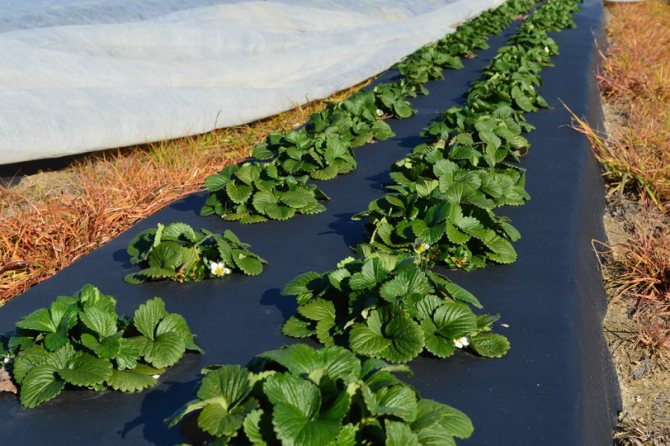

Two-layer covering material is used as mulch and protection against negative weather conditions. The light layer neutralizes excessive sun exposure and prevents plantings from overheating. The lower tier suppresses the development of weeds. Reinforced models with increased strength can be used to create paths in the garden, vegetable garden.
The thinner the raw material, the better the breathability.
White fiber with a density of 17 to 40 g / m2 transmits light, maintains an optimal microclimate, and therefore is only suitable for arranging greenhouses. Spunbond is not afraid of temperature fluctuations in the range from +100 to -50 ° С. Weed products do not react with chemicals and do not emit toxins.
Geotextile
Non-woven covering material is made from polyester fibers. With the help of thermal bonding, the threads are woven into fabric. The resulting canvas is very strong, air permeable.Weed control geotextiles are popular because of:
- low cost;
- durability;
- clear installation;
- versatility.
Agrospan
Russian products in terms of quality and directions of use almost do not differ from spunbond. UV stabilizers protect the fabric from sunlight. Inexpensive covering material is used in the cultivation of garden strawberries, strawberries and berry plants. Agrospan, which is resistant to wear, can be left for the winter, but it shows the best results when fighting harmful grasses.
Agrotex
A well-known Russian trade mark offers several types of popular raw materials. The yellow version is used to kill insects on nightshade crops. The use of black geotextile from weeds makes it easier to care for strawberries: during the season, the high temperature does not burn the berries, and soil mud after watering does not stain the crop.
The perforated surface makes the work of the farmer easier, eliminates the need for manual cutting of holes for plants. The covering material from the roll does not deform due to temperature extremes, suppresses the formation of pathogenic bacteria. It is rolled out on the site, the seedlings are placed in the holes.
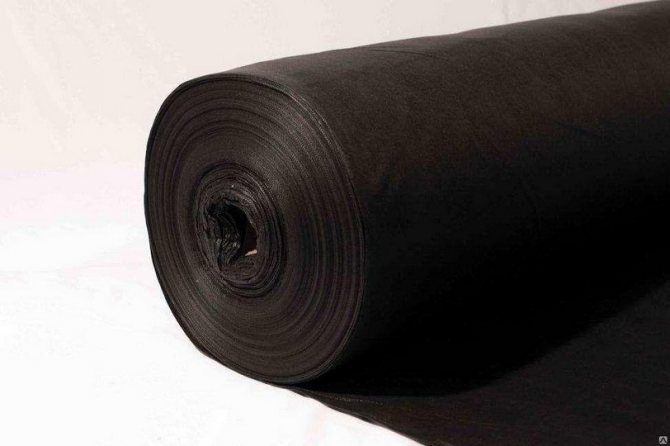

Agril
High air permeability is used for weed control. Crops do not suffer in heat and do not freeze in frost. Agryl protects the soil from crusting and erosion. If you install it correctly on the site, then the plants will give an early harvest. The transparent form has a density of 17 and 40 g / m2, transmits sunlight and is used in greenhouses.
The characteristics of the black covering material are 50 g / m2, therefore it is suitable for weed control on the site. If strawberries and vegetables are mulched with a cloth, then biological processes in the earth are not interrupted. Oxygen enters the root system, the moisture level is not disturbed.
Lumitex
The soft corrugated film is available in several colors. Agrofibre transforms the sun's rays, leaving only the ones needed for the development of plants, especially in cloudy weather. Reflective properties are suitable for hiding cucumbers and strawberries, exclude dangerous overheating and freezing, accelerate the ripening of the crop. When equipping greenhouses, a summer resident can combine lumitex with polyethylene.
Lutrasil
German agrotextiles are produced in two types - spun and non-woven. The first option is used for greenhouses and row spacings, the second can be mulched. The structure of the canvas resembles a thin web. The fabric is breathable, so condensation never forms underneath. It is produced in different density options - from 17 to 60 g / m2.
Black film
Inexpensive covering material is used for mulching beds, and reinforced material is used in landscape design. The product does not allow air to pass through well, therefore fungi and rot may appear from condensation under the layer. The dark upper tier is very hot from the sun, which is contraindicated for seedlings. The black weed film helps to suppress the development of harmful plants. To minimize the negative properties, it is necessary to sprinkle the structure with straw on top.
Reviews of gardeners
To cover my lawn in my summer cottage, I have always used lutrasil. The covering material has served me five seasons. Of course, agrotechnical fabric is most often used as mulch, but I prefer to lay it on the lawn with the arrival of winter. In principle, I am satisfied with the agromaterial, it is ideal for home use.
Igor, 35 years old
I have been growing vegetables for a long time. There are several greenhouses in my summer cottage. As a rule, with the onset of cold weather, you have to use covering material in order to preserve crops. Most often I use agrospan - a covering material, the characteristics of which are completely satisfactory to me. Agro-canvas has proven itself well among other nonwovens.
Ilya, 45 years old
Previously, I used ultrasil to cover crops.But recently I began to use acrylic, as it seems to me that it keeps plants from frost much better. Convenient in that it can be laid on the beds by either side. Of course, in the open field, crops cannot be saved from severe frosts, but this covering material is ideal for greenhouses.
Alexey, 44 years old
Operating principle
Covering material is necessary to cover the beds, flower beds. The fibers keep the sunlight out, which the weeds need to grow. Grasses try to make their way to the sun, are depleted and perish. A canvas is laid above the surface of the earth, cuts are made in the places of planting.
Modern options exclude root rotting, the occurrence of fungal diseases.
If you put a dense black and yellow material, you can get rid of parasites. Insects cease to orient themselves in space, reproduction stops. A protective plastic film with a black and white coating is used when growing garden strawberries. The canvases do not impede the processes of irrigation and fertilization, they save you from tedious weeding.


How to use spunbond in gardening
In the spring
To quickly warm up the ground, it is enough to put the canvas on snow or soil. Heat is generated under the material and the surface of the earth, which is transferred to the soil.
When the ground warms up, I don't move the spunbond far away. I plant radishes, lettuce in the greenhouse, covering the seedlings with an additional blanket.
Then comes the turn of zucchini, cucumbers, pumpkins. Heat-loving crops under cover start growing faster. And if there is a danger of freezing, and the temperature at night is approaching zero, then in the greenhouse and under the spunbond the plants do not feel the cold.
I wrap dahlia bushes and other flowers that are afraid of night frosts in small pieces of material. When the temperature drops, even a shelter on top of the plants can play a big role - spunbond will not let the cold air flow through, retaining heat.
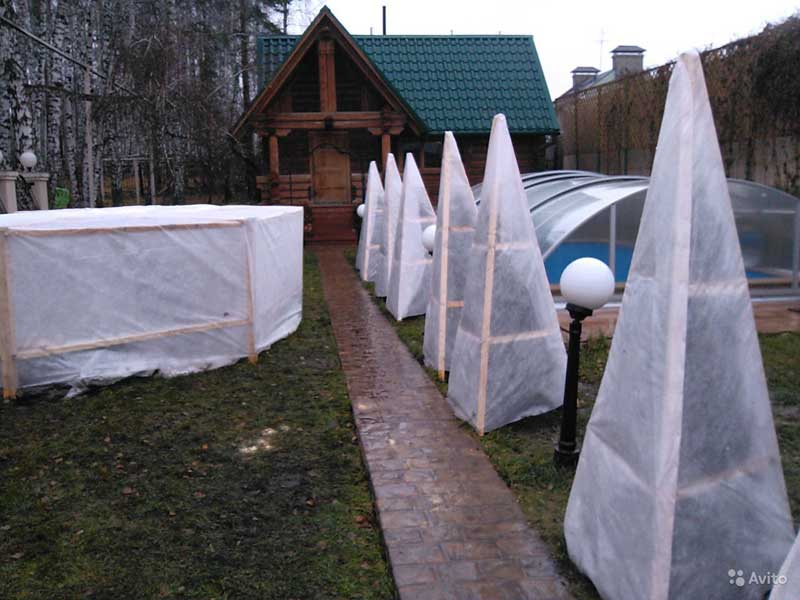

In summer
I grow sweet peppers in a large greenhouse, and from spunbond I build a small greenhouse, where bitter peppers yield. In the heat, I raise the material to the side for ventilation.
- The canvas perfectly transmits light.
- Demonstrates excellent thermal insulation.
- I water from the side, as well as from above directly onto the material. By watering, I slightly press down in the right place so that it is there that water falls on the bush and the ground.
Black spunbond is used for mulching the soil of strawberries and strawberries and protecting it from various birds and pests: rodents, slugs, bear.
And also weeds do not grow under the shelter and there are practically no erosion processes that occur during strong windy weather. In the heat, the root system does not overheat, but in the cold it is warmed up by the covering material.
Important! Spunbond allows water to pass through during irrigation or rains, but the evaporation of moisture from the surface of the earth is greatly slowed down.
I also use the canvas for mulching gooseberry and currant bushes. Previously, branches with berries were in contact with the ground. In wet weather, there was a danger of infection with gray rot, then with the use of spunbond, the likelihood of infection decreased significantly.


In autumn
I do not remove spunbond. The canvas plays the role of a reliable shelter when the first frost occurs in October in the absence of snow cover. Perennial plants with such protection more easily go into the stage of deep dormancy.
In winter
During the winter months, including March, when spring is slow to take over, spunbond continues to protect crops. "Spunbond blanket" warms young seedlings of fruit trees and shrubs during a cold, weakens the effect of temperature changes.


Advantages and disadvantages of using
Mulching the beds with covering material is a useful procedure that will make it easier to grow vegetables, berries and flowers. The popular weed control has advantages over manual loosening:
- Protection from the negative environment.Young plants do not suffer from a lack of moisture, nutrition, do not die from excessive solar activity. The upper soil layer is not compacted, does not collapse under the influence of precipitation, irrigation.
- Optimal conditions for development. A natural microclimate is created under the film, encouraging crops to grow. Disease-causing bacteria do not take root.
- Ease of maintenance. Protection does not interfere with irrigation, liquid fertilization.
- Versatility. Covering material can be put on the garden bed, cover the surfaces of the greenhouse or equip the garden path.
- Resistant to wear and tear. Agrofibre has a dense structure, so it retains its original appearance and quality for a long time. Manufacturers claim that the products can withstand 7 to 12 seasons of active use.
If you install a shelter from weeds with errors or violate the rules of operation, you can harm cultivated plants: condensation will begin to accumulate under the film, which, in the absence of light and air, will lead to the appearance of fungi and the death of plantings.
Black canvases get very hot, so in hot climates it is imperative to protect garden and vegetable plantations with mowed grass, wood chips or newspapers. The UV stabilizer layer breaks down after 2 months of use.
Polypropylene material - agricultural use
2 types of materials are used to shelter garden and horticultural crops: non-woven and polyethylene. Non-woven fabric (agrofibre) is more popular because it has many advantages over film. It does not harm the environment, lightweight (they cover the beds without using a support), "breathable" and water-permeable. But because of these features, it retains heat worse than polyethylene.
The main function of polypropylene, of which agrotechnical fabric is composed, is protective. It protects plants from short-term spring frosts, wind, scorching summer sun, and prevents the attack of harmful insects. And also the fiber creates a microclimate favorable for crops on the beds, preventing the rapid evaporation of moisture and drying out of the top layer of the soil.
The composition of the canvas includes ultraviolet stabilizers (UV stabilizers), which protect the canvas from the damaging effects of sunlight. Thanks to this feature, the material is durable.
The material is used not only in the agricultural industry, but also for the production of disposable medical gowns, shoe covers, feminine hygiene products, baby diapers, as well as in construction and furniture production.
The use of agrotextile to cover the beds has a positive effect on the future harvest:
- yield indicators increase significantly;
- covered fruits ripen earlier than uncovered ones;
- the growing season of many crops is prolonged, hence the fruiting.
What to look for when buying material
A high-quality covering fabric against weeds is a guarantee of the health and safety of cultivated plants. Experienced farmers are not advised to purchase agrofibre without branded packaging. Often the user thinks that the film is called spunbond, lutrasil or lumitex. Under the guise of an expensive trademark, a cheap fake is hiding, which does not correspond to the declared properties.
The way of using raw materials depends on its characteristics. If the fabric has a density in the range of 17-30 g / m2, then the option is convenient for protection from the cold. The 42 and 60 thicknesses are suitable for both compact greenhouses and large greenhouses. Products with indicators of 60 and above suppress the development of weeds, protect crops from drought and low temperatures. The "UV" mark on the label indicates the presence of an ultraviolet stabilizer.
Lutrasil, its types
One of the main characteristics when choosing lutrasil is its density. It is usually indicated by numbers next to the name, for example:
- lutrasil thermoselect 17
- lutrasil thermoselect 23
- lutrasil frostselect 30
- lutrasil frostselect 60
The lightest and thinnest with a density of 17 grams per square meter.It looks no denser than a cobweb. Able to protect from frost down to - 2 degrees. The material with a density of 30 g / m2 keeps frost up to -6 and serves as protection from heavy rain, wind and hail. Some of the densest variants of lutrasil with a density of 42 and 60 grams per square meter are suitable for creating greenhouses and greenhouses. Separately, it should be said about Lutrasil 60 UV. It is dyed black by the addition of carbon black, elastic and sun-proof. If it is spread on the garden bed, then the weed vegetation under it does not develop. Thus, depending on the density, other characteristics, lutrasil has four main purposes:
- protection against unfavorable temperatures protection against atmospheric agents
- soil mulching
- weed control
When choosing a lutrasil for a summer cottage or garden plot, a combination of price, quality and durability is important.
How to lay the black weed film?
In order for agrofibre to help against harmful plants, it is necessary to use it correctly. The covering cloth is placed in the spring on dry, debris-free soil. The black film must be spread over the entire surface of the protected area, secured around the entire perimeter with boards or stones.
Seedlings are planted in special slots made with a knife in the shape of the letter X. If the holes are large and the agrotextile is light, then the weeds will continue to develop. For the winter, the material is removed from the garden, washed and disinfected with fungicides.


What is the difference between covering canvases
Covering nonwovens are quite similar in appearance, but still differ from each other. When choosing them, it is imperative to take into account the marking of the product, which is indicated by numbers. The higher it is, the denser the material. It will also keep you warm much better.


The thinnest and lightest covering materials are well suited for frameless shelters. In addition, they have very excellent light transmission, helping to create favorable conditions for growing plants. Moreover, such products can protect plants from insect pests and birds.
Covering nonwovens, marked with number 23, have the same qualities as thinner products, but they are much stronger. To provide protection against severe frost, items marked # 30 and # 42 are ideal as they help to ensure the best possible conditions.
It is worth noting that without a frame, only light non-woven covering material can be used, and for denser and stronger products, a reliable and stable frame is required. The most durable products are considered models with markings No. 60 and No. 80.
Approximate prices for covering material
The cost of weed control products depends on the brand, density and roll width. Russian products are much cheaper than their Western European counterparts. Black agrotex costs 55 rubles per meter, and green spunbond - 40. The thicker the film, the more expensive it is. A thin transparent covering material is estimated at 15 rubles. / m, and with characteristics of 60 g / m2 - 47.
It is easy to get a fake by purchasing weed control raw materials from open packaging without a label. Verified retailers will provide a certificate.
If you buy products in bulk, you can save up to 20%. Rolls are from 150 to 300 m. The width of agrofibre is produced (in m):
Weed cover is a great way to ease the physical effort of maintaining a site. In order for crops to grow without problems, it is necessary to choose and install the black film correctly. Agrofibre is good for oxygen permeability, suppresses the development of harmful grasses and protects the soil from erosion. Protected from a negative environment, vegetables and berries ripen faster.
Manufacturers
Spunbond is widely represented in our country today and its production is mastered by many companies.
The leading brands are:
- Lutrasil (Germany);
- Agril (France);
- Agrin (Ukraine);
- Agrotex (Russia);
- Plant-Protex (Poland).
As you can see, new engineering solutions make it possible to significantly simplify the work of an agricultural producer and facilitate the work of summer residents. Such an innovative material as spunbond will allow not only to get a good harvest in the current season, but also to maintain the germination of plants next year.
Lumitex - protection against negative ultraviolet rays
This material is capable of transmitting blue and red rays of the ultraviolet spectrum. Moreover, lumitex also converts green rays into blue, which enhances the flow of active radiation, reflecting and retaining that part of the radiation that is harmful to plants.
Lumitex differs not only in its properties from other materials, but also in its appearance: it is soft, corrugated, pinkish in color. It is most often used to protect strawberry and cucumber beds, which ensures harvesting 12-15 days earlier. In addition, the yield increases by 35-45%. Lumitex is often used with plastic wrap. For this, the walls of greenhouses are covered with lumitex, and the roof is covered with foil. A running meter of lumitex costs from 90 rubles.
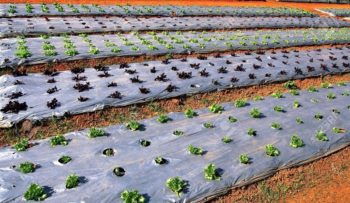

There are many varieties of covering material, which differs not only in appearance, but also in density, properties and the material itself (film or fabric)
Agrospan
Covering material agrospan is suitable for use at any time of the year. This canvas combines the best qualities of other products. In the cold season, it helps protect seeds, seedlings and seedlings from frost. In summer, it provides protection against excessive amounts of ultraviolet radiation.
Agrospan is a synthetic fiber that looks like non-woven fabric. Manufacturers produce canvases in black and white. The white material is ideal for covering seedlings in a greenhouse or greenhouse. Black material is used for soil mulching. It provides protection against weeds and pests.
With the help of new technologies used in the production process, a strong and durable canvas is obtained. It has the following advantages:
- creation of the required microclimate;
- protection against overheating and excessive cooling of the soil;
- decrease in watering;
- protection from pests and diseases;
- durability.
However, this fiber also has certain disadvantages. The main disadvantage is considered to be a low level of thermal insulation, which is very bad for the growth of heat-loving plants.


